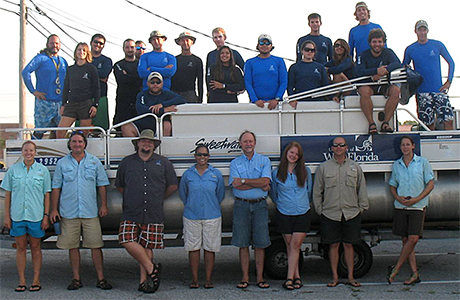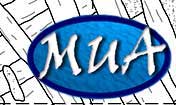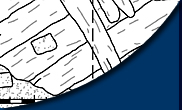
“Parting is such sweet sorrow” -
October 1, 2009
The 2009 field school has come to a close. This summer’s excavation truly was one of the best underwater archaeological field schools conducted at the University of West Florida and yet represents only a small fraction of the research, conservation, and study to come. Everyone involved in this project appreciates the overwhelming amount of international attention and support this project has brought and is eager to begin again next year.

Maritime Archaeology Students and Faculty at the University of West Florida 2009 Field School. (Large View)
The following text is a summary of all that has been accomplished this summer:
EP2
The 2009 excavations uncovered large sections of the stern of Emanuel Point II. The structural elements will be studied by archaeologists for decades to come and will provide details about 16th-century Spanish ship construction once thought to be lost forever to history.
The excavations in the amidships’ unit were an extension from last year’s excavation in search of the elusive maststep. Students opened a unit adjacent to one opened last year and excavated straight down. Within this central unit was ceramic fragments, seeds, bones, a piece of wooden treenail, and one student even found two cannonballs amongst the oyster shells and ballast stones, but alas, no maststep. Two strange structural elements, we are a tentatively calling buttress timbers, did appear however, suggesting that that the maststep may be but centimeters to the southwest of the amidship units.
Once the amidships were closed, the divers moved on to the first of two units opened outside the hull of the ship, which were created with the purpose of determining the extent of EPII’s artifact scatter. Many of the artifacts encountered were large concretions. The field school excavated to sterile sediment, approximately 60 centimeters in this location, before deciding to move our unit to another location further outside the ship’s structure. The second one was created 13 meters from the baseline and was still producing artifacts. This knowledge could help us determine how far the site extends.
B-Street Schooner
This summer the students were also able to work on a mid19th century vessel that is located in Pensacola Bay, near Bayou Chico, The B-Street Schooner. Since this summer marks the beginning of investigations on this site, we set up the baseline for the site from which our measurements and unit numbers will be based from. With the baseline setup, we triangulated in the first unit on the site to begin excavating. By the end of the summer a 2x2m unit in the amidships, five meters east of the baseline was completed. Excavating this unit was difficult, due to extreme slumping caused by the soft sand. For every handful that was dredged more sand fell back in. Also, to our surprise, the unit is also full of criss-crossing stacked pieces of lumber, making it unfeasible to reach the hull of the ship. Upon further investigation the lumber appears to be both hand sawn and band sawn, which will help us obtain a more precise date for the vessel. Some interesting artifacts were recovered from the unit this summer. We recovered a musket shot, two stoneware ceramic shards, and some concretions. Two of the concretions have been processed in the lab, one of which turned out to be a spike while the other is strange metal object that has tentatively been identified as a brake block for a train. These artifacts along with the lumber have led us to re-think the date of the vessel. Originally, it was believed to date from late 19th century, but now we believe it to date to the mid 1800’s.
Hopefully, work will continue exposing more diagnostic hull structure, as well as mapping in features of the shipwreck, such as a centerline timer and the no doubt many artifacts within the schooner. Ideally, through further excavation and research, we will be able to analyze the ship’s hull structure, determine the ships use and how the B-Street Schooner fits in the maritime landscape of historic Pensacola.
Survey
An important part of the field school this year was training in different methods of survey. The survey methods used in the field included side-scan sonar, magnetometer, and target diving. These methods were practiced by students and supervisors in the relatively shallow waters of Pensacola Bay near Emanuel Point and in Bayou Texar on the north side of Pensacola Bay. After each day of survey, the students learned to look for anomalies that showed up in the side-scan and magnetometer data that they collected. All of the data collected during these surveys was combined with previous surveys and geo-referenced in a program known as Hypack. Students and supervisors learned to use this program as part of their survey training. Using Hypack, the team combined the anomalies identified through the side-scan sonar and the magnetometer surveys and identified targets with higher probabilities of being shipwrecks. Using this data, supervisors took students out to dive these “high probability” targets and had them perform circle searches in order to “dive-truth” these targets.
Unfortunately no new shipwrecks were located this summer but Pensacola Bay is very large. There are currently three shipwrecks being excavated by the University of West Florida archaeologists. There are also shipwrecks around Pensacola that have yet to be located and you can bet that when they are, the maritime archaeologists at the University of West Florida will be there.
Conservation
Although much of the public interest, media, and focus has been on the field operations and the artifacts recovered during UWF’s 2009 Maritime Field School another aspect of the field school requires coverage as well, and that is artifact conservation. To date graduate supervisors and field school students have recorded 590 artifacts with at least the same amount awaiting documentation. Though the field school students will not complete every step of artifact conservation they are completing the most crucial steps in artifact conservation, and that is the initial recording.
Artifact conservation begins in the field when divers note the exact location, depth, and grid coordinates of features and notable artifacts as they are uncovered on the site. As far as dredging, students and supervisors sort the contents of dredge spoil bags at the end of the day, and bag all the recovered artifacts while labeling the artifact bags with the appropriate provenience information. After supervisors verify all of the information on the artifact bags is correct a supervisor places the artifacts in an artifact transport receptacle (ATR) otherwise known as a five-gallon bucket filled with fresh water, and transport the artifacts to the lab. Once in the lab the supervisor then places the artifacts into storage bins also filled with tap water to await the next step in conservation, and that is starting the artifact conservation forms.
During previous field schools faculty and graduate supervisors experimented with various ways of recording the artifacts once they were in the lab (usually in the fall when the field school students were not around). Though all of these methods proved to be workable the supervisors tried something slightly different this summer, and it turned out to be a bonanza of an idea. The idea was to get the field school students more intrinsically involved in the process of artifact conservation. Instead of having students just recover artifacts in the field and seeing them disappear in an ATR two or three students with a graduate supervisor rotated through the lab two days a week. Under the supervision of the graduate lab director and the department’s artifact curation manager Norine Carroll students pulled artifacts from the storage bins and completed artifact conservation forms. This effort required weighing, measuring, drawing, and photographing each individual artifact no matter how big, small, mundane or glamorous. Throughout the entire process students, graduate supervisors, and faculty cross-checked each other's efforts resulting in a system that not only maintained proper information, it saved time. As graduate supervisor Colleen Reese noted “these students accomplished in two days what would have taken me an entire semester to do.”
Though the process of maintaining artifact provenience integrity is utmost, another aspect is equally important, and that is the introduction of students to proper laboratory methods. Most students probably envision field school as a time of diving, boat operations, sun, and fun while lab work may be the furthest thing from their minds. As it turns out, lab days were greatly anticipated by field school students here at UWF as it gave them an understanding of how important their work was out in the field (not to mention that they could actually enjoy a hot lunch). Seeing the problems in the lab that resulted from incorrect information being gathered reinforced the idea of proper artifact and information collection in the field. Also, students had the time to learn more about the proper use of laboratory tools, equipment, and the artifacts they were recovering.
All in all, the idea of getting students more involved with the conservation process during field school is an idea that will probably be around for sometime as it ensures a better end product. For the students that live locally many volunteer in the lab during the fall and spring semester, and want to work with the artifacts that they helped recover. In the end making the lab and artifact conservation a part of field school has turned out to valuable tool not only for the processing of artifacts, but for a better-rounded student preparing for work in archaeology.
The students of the 2009 field season would like to take this opportunity to thank our fearless leaders Dr. John Bratten and Greg Cook for their tireless support and imparting their wisdom onto the next generation of maritime archaeologists. In addition, we would like to recognize the tremendous efforts of the staff of the University’s Marine Services Center without whom we would literally have been dead in the water. We thank the heroes behind the scenes at the Florida Department of State, Division of Historical Resources who work every day to provide grants, permits, and protect our shared historic resources. Lastly we thank the Museum of Underwater Archeology for providing us a forum to present to the world our adventures under the sea. Thank you!
Please feel free to contact us if you have any questions or concerns at: mua@keimaps.com.
Return to Project Journal home page.

